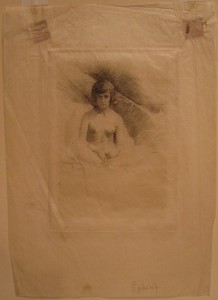(Click to Enlarge)
10 3/4 x 7 7/8 inches as a complete piece attached to a larger backing
Composed etching measuring approximately 6 1/2 x 4 3/4 inches.
Signed Sphinx in pencil lower right.
En verso signed in pencil Jules de Goncourt in different hand, an incorrect attribution to 19th century Parisian writer and artist Jules de Goncourt.
Depicts a prostitute at the famous/infamous Le Sphinx in 1930s Paris.
Le Sphinx was a brothel, which was opened in 1931 in Paris. In 1946. Le Sphinx was among the most expensive and best known maisons de tolérance in the Paris of the 1930s. It was also frequented by German officers during the war.
Le Sphinx was a celebrated Parisian brothel, located at 31 Boulevard Edgar Quinet in Montparnasse, which Brassai describes in The Secret Paris of the 30’s (London, 1976). It flourished during the 1930s and was a favourite haunt of artists. Giacometti was a regular visitor and regarded it as ‘a place more marvellous than any other’ (quoted in James Lord, Giacometti, New York, 1985, p.78). His bronze sculpture, ‘Quatre Figurines sur Bas’ 1950 and 1965, represents ‘Several nude women seen at the “Sphinx”’ (letter from Giacometti to Pierre Matisse); there is a cast in the Tate’s collection (T00773). James Boswell visited Le Sphinx in the early part of 1937 and this experience directly inspired the drawings which were executed shortly after, in the artist’s home at Charlbert Court, St John’s Wood, London. wwwtatedotorg
After the war, Marthe Richard, a town councillor in Paris who had been a prostitute herself, campaigned for the closure of all brothels, and the “loi de Marthe Richard” was passed on April 13, 1946, closing the legal brothels in France. Roughly 20,000 women were affected by this law and approximately 1400 houses closed.




